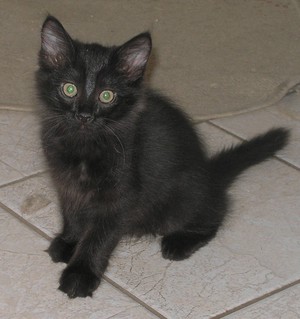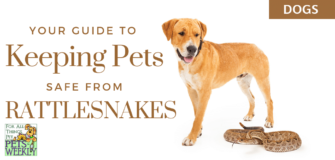Teaching Children to Approach Horses
Share
I have a problem with parents who just allow their kids just run up to strange animals. In fact today, a very young child somehow made it underneath the stomach of my blind horse.
I can’t begin to express the danger that a 1,300 lb animal presents to a 30 lb child – especially one who can’t see the child! I am grateful that my hooved partner is so responsive to what I say and stood firmly. If not, this child could have easily been killed. I can’t imagine what could have happened had my horse been a younger or more reactive animal.
Allowing your child to run up to an unknown animal, or approaching one yourself, can be very dangerous.
It doesn’t matter how well-trained or well-behaved an animal is, approaching them blindly is dangerous. By not teaching proper etiquette, a child’s, an animal’s, the handler’s, and possibly your own life may be at risk. Don’t risk yourself or your children.
[heading style=”modern-1-light” color=”#3a5472″ style_color=”#06192e” align=”left”]The Proper Way To Approach Horses[/heading]
Horses are prey animals, meaning their first response is a fear response. They are large. They are powerful. It’s important to respect both what they are and what they are capable of.
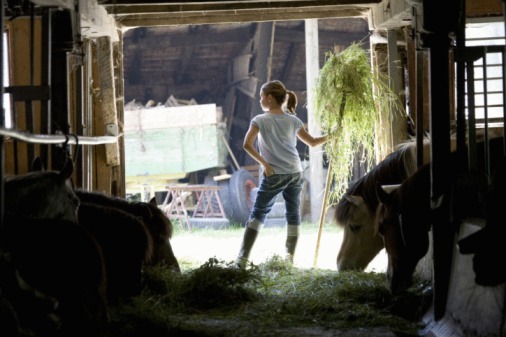
Be aware that horses can strike out with any of their hooves in almost any direction and they can also bite. It is very important that you pay attention to what the handler says, and be aware of some simple truths about prey animals.
[heading style=”modern-1-light” color=”#3a5472″ style_color=”#06192e” align=”left”]Always Ask to Approach[/heading]
The first step is to ask the rider, from a safe distance of at least ten feet, if you may approach the horse. Speak normally and calmly. Do not yell or scream. When the rider gives permission, slowly approach the horse, towards the rider’s left stirrup, (your other left when you face the horse) unless the rider tells you otherwise. If the horse is curious about you, it will turn it’s head.
Horses under saddle are accustomed to things happening along the area near their left shoulder. This is where the rider stands to put the saddle on and where they mount. It is harder for a horse to bite you that far from their mouth, and one of the more difficult places for them to kick at you. So for your own safety this is a better place to stand.
If the horse is being led, approach the handler first, then allow them to lead you through the interaction. Everyone wants to pet a horse’s face but petting the neck/shoulder is much safer for you, and less likely to frighten the horse. Don’t touch the equipment on the horse, or anything the rider/handler doesn’t give you permission to touch. Some animals are very head shy, others are sensitive near the belly or feet. Be aware of these potential sensitivities.
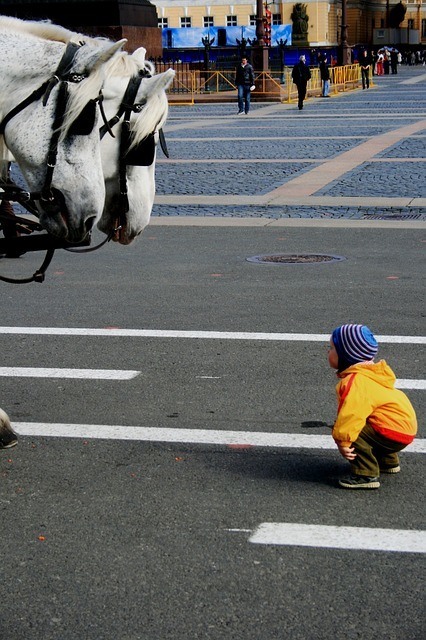
[heading style=”modern-1-light” color=”#3a5472″ style_color=”#06192e” align=”left”]Approaching A Horse With a Child[/heading]
For your child’s safety, pick your kids up prior to approaching a horse, unless the child is taller than the horse’s elbow. This keeps your child’s head in a much more difficult area for a horse to hit with a hoof. Even when a rider says that the horse is “perfectly safe”, it is much better for everyone to keep your child in hand. Children are particularly scary for horses since they are small, quick-moving and often loud. A child could very easily dart under the stomach of a horse, (TRUST ME) and this can take a nice interaction into the danger zone faster than you can imagine.
If the horse is being led by a handler, you should still follow these steps. At the very least, keep a hold of your child’s hand. Let the child pat the horse on the shoulder, and never allow them to tug on the equipment or mane. While 9 out of 10 horses would be fine, if your child runs up to the one sensitive horse, there is a very real chance they could be badly harmed or even killed.

[heading style=”modern-1-light” color=”#3a5472″ style_color=”#06192e” align=”left”]How to Pet A Strange Horse[/heading]
I believe it was Monty Roberts who said that approaching a horse with an open palm is threatening because that is the way a big cat would swipe at them. Think about that for a second… You think you’re being nice and showing you mean no harm, when really, you’re presenting an actual threat without meaning to. The author of that piece also suggested using the back of your hand to present to the horse and pet them.
[note style=”5″ type=”danger” icon=”yes” class=”template-style”]Keep your child in sight at all times![/note][heading style=”modern-1-light” color=”#3a5472″ style_color=”#06192e” align=”left”]Approaching horse in barn[/heading]
If you’re at someone’s home where a horse is kept, or at a boarding facility or barn, KEEP YOUR CHILD IN SIGHT AT ALL TIMES.
- Do NOT let them go running off, and do not let them run around the grounds. They could spook the horses, and if the animal feels that it cannot escape (which they will always try to do first) they may lash out. This is not viciousness, it is FEAR.
- Do not let your child feed the horse by hand. Especially if there are multiple animals in the enclosure. Horses, as any other animal, can be aggressive about food. Ask if your child can put a treat in the horse’s bucket.
- If the owner or caretaker says that it is okay to feed the horses by hand, ask them to show you how it’s done. This is a great time to watch for any signs of aggression, and watch how the animals interact with each other and the handler.
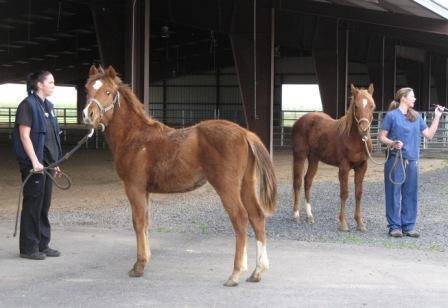
[heading style=”modern-1-light” color=”#3a5472″ style_color=”#06192e” align=”left”]Horses communicate like cats[/heading]
Lashing tails, ears laid flat, lifting the hind leg, stomping hooves, bared teeth – all of these can be signs of irritation and possible aggressive action. While horses also lift their legs, stomp and swish their tails at flies, it’s always worth noting these behaviors.
In horse language, an animal that displaces another and makes it move is higher ranking, so a pushy horse is a disrespectful horse. Horses faces are not nearly as expressive as a dog or cat, but they communicate just as clearly if you watch carefully. While you are on the grounds of somewhere with horses or other large animals, stay out of their pens unless invited by the owner, handler or caretakers.
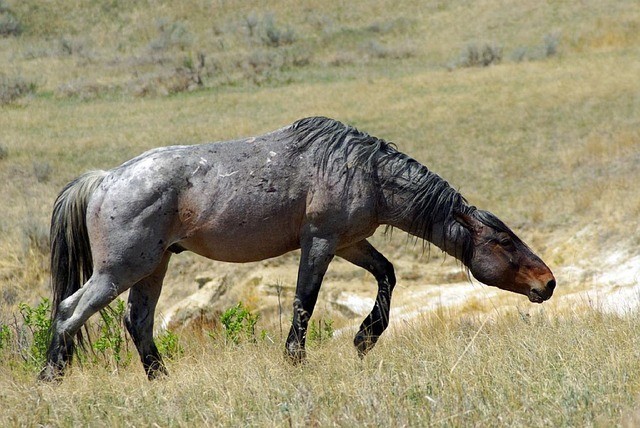
[heading style=”modern-1-light” color=”#3a5472″ style_color=”#06192e” align=”left”]Stay at least 6 feet from the edges of the pen.[/heading]
Some animals are territorial and may lunge at you over or through the fence. Do not allow your child to poke sticks or anything else through the fences at the animals. Children poking at caged animals is sadly something seen often. And whatever you do, do NOT let go of your child’s hand. At a boarding stable a boarder could be coming or going from the barn at any time, and children running could upset the animals and get the handler or themselves hurt. I’m not trying to scare you, but it is just so important to be careful. The handlers would be distraught if something happened to you and your child, and you would be heartbroken if a nice day out with your child became a last day out with your child.
[heading style=”modern-1-light” color=”#3a5472″ style_color=”#06192e” align=”left”]Never Assume Others Are Watching Your Child[/heading]
After nearly 25 years of daily interaction with horses, I can still be surprised, and have been severely injured. I knew what I was getting into, but you and your child may not.
[note style=”5″ type=”danger” icon=”yes” class=”template-style”]NEVER ASSUME THAT SOMEONE ELSE IS WATCHING YOUR CHILD.[/note]Unfortunately, I hear this so many times when someone’s child gets hurt, “Well I thought so-and-so was watching him!” This is one responsibility you should never delegate, especially to strangers. At a boarding facility, equine event or show, everyone is focused on what they have to do, and they may not even notice a child running around.
Horses can become hyper-focused on the tasks at hand also, and a person who is in the way can get injured without the horse even noticing. The above rules also go for horse shows and other events. Even if you and your child are accustomed to horses, there is still a danger. You never know what is going to happen, and if you bring your child with you to an event, and they don’t listen or behave, they could be injured or far worse.
Adults also need to focus on what’s going on around them. You never know when an excited horse will get out of hand, or just be frisking and pin you against a fence. It doesn’t take much with animals that big. It’s so important to pay attention. In any situation like that I’ve ever personally seen, the horse has ALWAYS tried to avoid hurting the person, but sometimes they don’t notice the person fast enough.
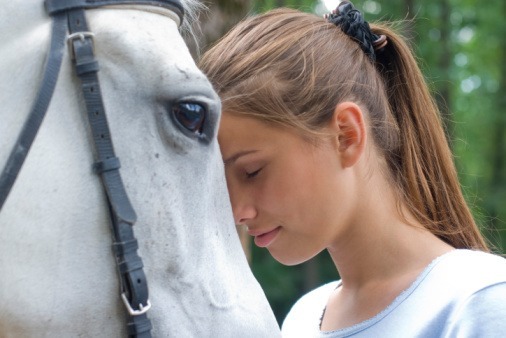
[heading style=”modern-1-light” color=”#3a5472″ style_color=”#06192e” align=”left”]Responsible Organizations for Children to Learn About Animals[/heading]
If you are interested in having your child learn about horses, have them join a local 4H horse club, take lessons at a local barn, or join a group like the FFA. A local large animal rescue or therapeutic riding center may have opportunities to help exercise horses, participate in chores associated with animals, or even to help you find a trainer. Local universities may have volunteer programs, and large animal veterinarians may be able to recommend educational programs.
Remember that while your friend may have a horse at home there is a huge liability risk when you ask your friends to let you or your child ride their horse. Most smart horse owners will end up saying no or at the least have you sign a liability release. This isn’t an aspersion on you, but in today’s litigious society, it is not in their best interest to allow you to associate with their horses without at least a release. You really never know how someone will react to themselves or their child getting thrown, and most people don’t carry the extremely expensive insurance riders required to cover situations like that.
This is another reason to teach your child to only approach a horse when with you AND the horse’s handler – some kids take it upon themselves to hop on a neighbor’s horse from the fence, or approach a horse without you they have previously interacted with and have gotten badly hurt. It is imperative they understand this is not in their best interest. Even by feeding a horse a potentially dangerous plant (like oleander or other things that grow wild near paddocks), you or they could inadvertently sicken or even kill the animal.
Please take some time, especially if you live in a neighborhood with equestrians, to teach your child how to be safe around horses, and to never feed horses random plants or fruits they find lying around. You might mean well but you, the horse, the handler, or the child may end up getting hurt.
It’s natural to be curious about horses and to want to meet these animals – we hope these tips will give you ideas on how to do so safely.
[note style=”5″ type=”warning” icon=”yes” class=”template-style”]Remember: interacting with any animal contains an element of risk. The author assumes no responsibility for any happenings if you approach a horse. These techniques come from years of experience in working with horses, but anything can happen when working with animals. Please be cautious and aware at all times.[/note]




